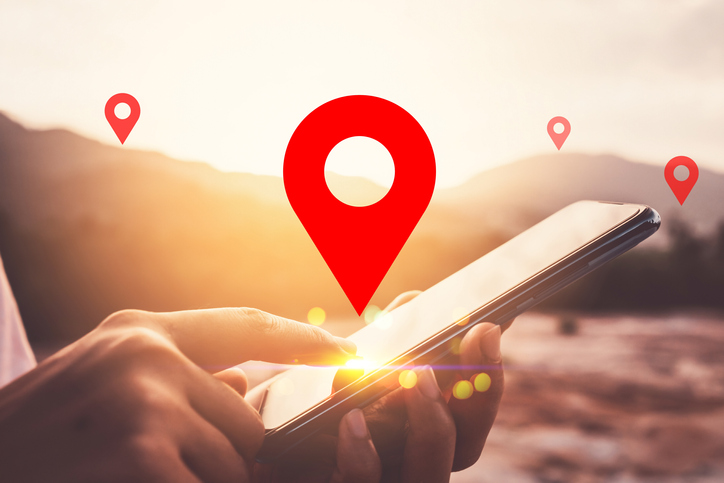
RFID and GPS are both tools businesses can use to track and identify their assets’ current whereabouts. However, there are several differences between these two processes. But before we get into the details of RFID vs GPS tracking, let’s first define how each of these processes works.
What Is RFID?
Radio-frequency identification (RFID) uses radio waves and signals to exchange information about an asset. There are two required components necessary: a reader and a tag (also called a chip).
- Reader: The reader is a scanning device that activates the tag/chip. Once activating the tag, the reader can gather unique information about the attached asset, identify it, and upload that information into a centralized asset tracking database.
- Tag/Chip: The tag/chip has a circuit and antenna that transmits an asset’s unique information to the reader. Each tag is coded with unique information prior to being attached to the asset.
RFID is a “passive” tracking method, meaning it only transmits information when the tag is activated by the reader.
What Is GPS?
Global Positioning System (GPS) uses satellites and GPS trackers to determine an asset’s approximate location.
- Satellites: Satellites orbit the planet approximately twice each day and transmit a unique signal that GPS trackers can receive.
- GPS Tracker: A GPS tracker will scan and receive signals from several satellites to triangulate an approximate location.
GPS is an “active-tracker” method, meaning you can check where an asset is at any moment.
RFID vs GPS Tracking: How Do They Compare?
As you can probably tell, GPS and RFID asset tracking methods are wildly unique from one another, using two completely different sets of technology. As such, each method has its own advantages and disadvantages, so let’s quickly address what those are for RFID vs GPS:
RFID Pros
- Long-lasting: RFID tags have a longer battery life since they’re part of a passive tracking system—the tag only has to power on when it is activated by a reader.
- No need for line of sight: For most other readers and scanners, there needs to be a clear line of sight between the reader and the tag. Since RFID deals with radio waves, that’s a non-issue. You can easily scan the vicinity of the tagged asset to gather its information.
- Quick response: The moment an RFID tag is read, it uploads information to your database—without any delay.
RFID Cons
- Susceptible to security breaches: RFID tags usually do not have any security measures built into them. As such, there is a risk of personal information being taken from those chips.
- Radio interference: Your reader may have trouble scanning an asset if there is a lot of radio interference while scanning the tag. This can lead to inaccurate or incomplete readings.
GPS Pros
- Around-the-clock tracking: GPS trackers are always transmitting their location. As such, they are incredibly simple to track. Just look at your database to get its real-time whereabouts.
- Reduced risk of theft: Since a GPS device’s location is always in your database, you can immediately be notified if an asset moves outside of its designated location or route.
- Highly accurate location: GPS asset trackers can be incredibly precise, often narrowing asset location down to a 7-meter diameter accuracy.
GPS Cons
- Lower battery life: Constantly sending out data has its downsides—GPS trackers lose battery life much faster because they are constantly powered on. While you can easily replace or recharge the battery, there is a risk of the battery dying. If that happens, you can no longer track the asset.
- Clear skies required: GPS trackers technically do not need line-of-sight contact with satellites. However, there must be minimal obstructions between the tracker and the satellite for you to pinpoint the asset.
How Can I Know Which Is Better for My Business?
Like most decisions, the right asset tracking service for your company is the one that best fits your needs. Here are some scenarios to consider:
- Where are your assets going? Are they leaving your organization’s building often? Are they associated with a job or location when they leave? If so, RFID should work just fine. If you don’t know where they are heading or when they will be back you may want to consider GPS.
- Are there checkpoints in your asset delivery? Checkpoints are funnels all of your assets will pass through, like a checkout desk or a receiving center. If a checkpoint is a part of your asset delivery system, RFID is probably sufficient. Otherwise, you may need GPS to keep track of your assets.
- Is theft a large issue for your assets? If an asset is truly irreplaceable, you may wish to use GPS to keep tabs on it at all times. (This is not to say that RFID has no anti-theft protocols, GPS simply has a more constant tracking mechanism.) Otherwise, RFID is probably your best bet.
Find the Right Asset Tracker for Your Organization
Whether your organization lends out assets to staff or to customers, you need to employ some kind of asset tracking management system. GPS can work perfectly fine, but it can be quite expensive if you have a lot of assets to track, and it may be unnecessary if those assets aren’t traveling very far. In this case, RFID tracking is the best option.
We hope you consider how Flex Asset Solutions’ RFID tracking software can help you take better care of your assets. Our RFID service is bundled with our regular asset solution to offer complete control and security over your physical assets. Start a live demo today and see how you can better protect your asset inventory.


